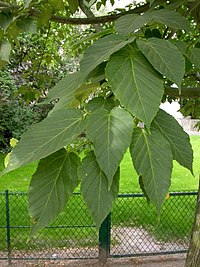David's Maple
| Habit | tree
| |
|---|---|---|
| Height: | ⇕ | 30 ft"ft" can not be assigned to a declared number type with value 30. |
| Width: | ⇔ | 25 ft"ft" can not be assigned to a declared number type with value 25. |
| Lifespan: | ⌛ | perennial |
| Origin: | ✈ | China |
| Bloom: | ❀ | early spring, mid spring, late spring |
| Exposure: | ☼ | sun |
|---|---|---|
| Features: | ✓ | deciduous, flowers |
| Minimum Temp: | ☃ | -25°C-13 °F <br />248.15 K <br />446.67 °R <br /> |
| USDA Zones: | 5 to 9 | |
| Sunset Zones: | 3-6, 15-17, 20, 21, 32-34 |
|
Acer > |
davidii > |
Acer davidii (Père David's Maple), is a species of maple in the snakebark maple group. It is native to China, from Jiangsu south to Fujian and Guangdong, and west to southeastern Gansu and Yunnan.[1]
The tree was originally discovered by Père Armand David who was in Central China as a missionary. It was re-discovered by Charles Maries during his visit to Jiangsu in 1878.[2]
It is a small deciduous tree growing to 10–15 m tall with a trunk up to 40 cm diameter, though usually smaller and often with multiple trunks, and a spreading crown of long, arching branches. The bark is smooth, olive-green with regular narrow pale vertical stripes on young trees, eventually becoming dull grey-brown at the base of old trees. The leaves are 6–18 cm long and 4–9 cm broad, with a petiole 3–6 cm long; they are dark green above, paler below, ovate, unlobed or weakly three-lobed, with a serrated margin. They turn to bright yellow, orange or red in the autumn. The flowers are small, yellow, with five sepals and petals about 4 mm long; they are produced on arching to pendulous 7–12 cm racemes in late spring, with male and female flowers on different racemes. The samara nutlets are 7–10 mm long and 4–6 mm broad, with a wing 2–3 cm long and 5 mm broad.[1][3][4]
Read about David's Maple in the Standard Cyclopedia of Horticulture
|
|---|
|
Acer davidii, Franch. Tree, to 50 ft.: branchlets glabrous: lys. ovate or oblong-ovate, 2 1/2-8 in. long, acuminate, subcordate or rounded at base, unequally crenate-serrate, green beneath and rufously villous on the veins while young, finally glabrous or nearly so: racemes slender, pendulous, glabrous: wings of fr. spreading horizontally. Cent. China.—Handsome tree; hardy at the Arnold Arboretum, the lvs. turning bright yellow or purple in autumn. In young plants, the lvs. are often lobed at the base.
|
- More information about this species can be found on the genus page.
Cultivation
- Do you have cultivation info on this plant? Edit this section!
Propagation
- Do you have propagation info on this plant? Edit this section!
Pests and diseases
- Do you have pest and disease info on this plant? Edit this section!
Varieties
There are two subspecies,[1][4] often treated as a distinct species:[3][5]
- Acer davidii subsp. davidii. Père David's Maple. Bark greenish-brown with white stripes. Shoots pinkish-green. Leaf petiole pink to red; leaf margin usually single-serrate with variably-sized serrations.
- Acer davidii subsp. grosseri (Pax) de Jong. Hers's Maple (Acer grosseri Pax; syn. Acer hersii Rehd.). Bark green with white to pale green stripes. Shoots green. Leaf petiole green; leaf margin more often three-lobed and double-serrate.
Along with A. rufinerve, the two subspecies of Père David's Maple are among the most commonly cultivated snakebark maples. Both are relatively hardy and fast-growing.[4]
Among the cultivars of A. davidii are 'Canton' (a Dutch cultivar with a purplish hue to its green stripes), 'George Forrest' (a Scottish cultivar with large leaves and dark red young shoots), 'Ernest Wilson' (a specimen of which may be viewed in the Westonbirt Arboretum in England), and 'Serpentine' (a cultivar with distinctively small, narrow leaves).[4][5] In some cases, these cultivars cannot be assigned to one subspecies the other but are simply considered cultivars of A. davidii.[4]
Gallery
If you have a photo of this plant, please upload it! Plus, there may be other photos available for you to add.
References
External links
- w:David's Maple. Some of the material on this page may be from Wikipedia, under the Creative Commons license.
- David's Maple QR Code (Size 50, 100, 200, 500)
- ↑ 1.0 1.1 1.2 Flora of China (draft): Aceraceae
- ↑ Stefan Drew. "Latin plant names make it abundantly clear". www.stefandrew.com. Retrieved on 19 October 2008.
- ↑ 3.0 3.1 Rushforth, K. (1999). Trees of Britain and Europe. Collins ISBN 0-00-220013-9.
- ↑ 4.0 4.1 4.2 4.3 4.4 van Gelderen, C. J. & van Gelderen, D. M. (1999). Maples for Gardens: A Color Encyclopedia.
- ↑ 5.0 5.1 Mitchell, A. F. (1974). A Field Guide to the Trees of Britain and Northern Europe. Collins ISBN 0-00-212035-6
